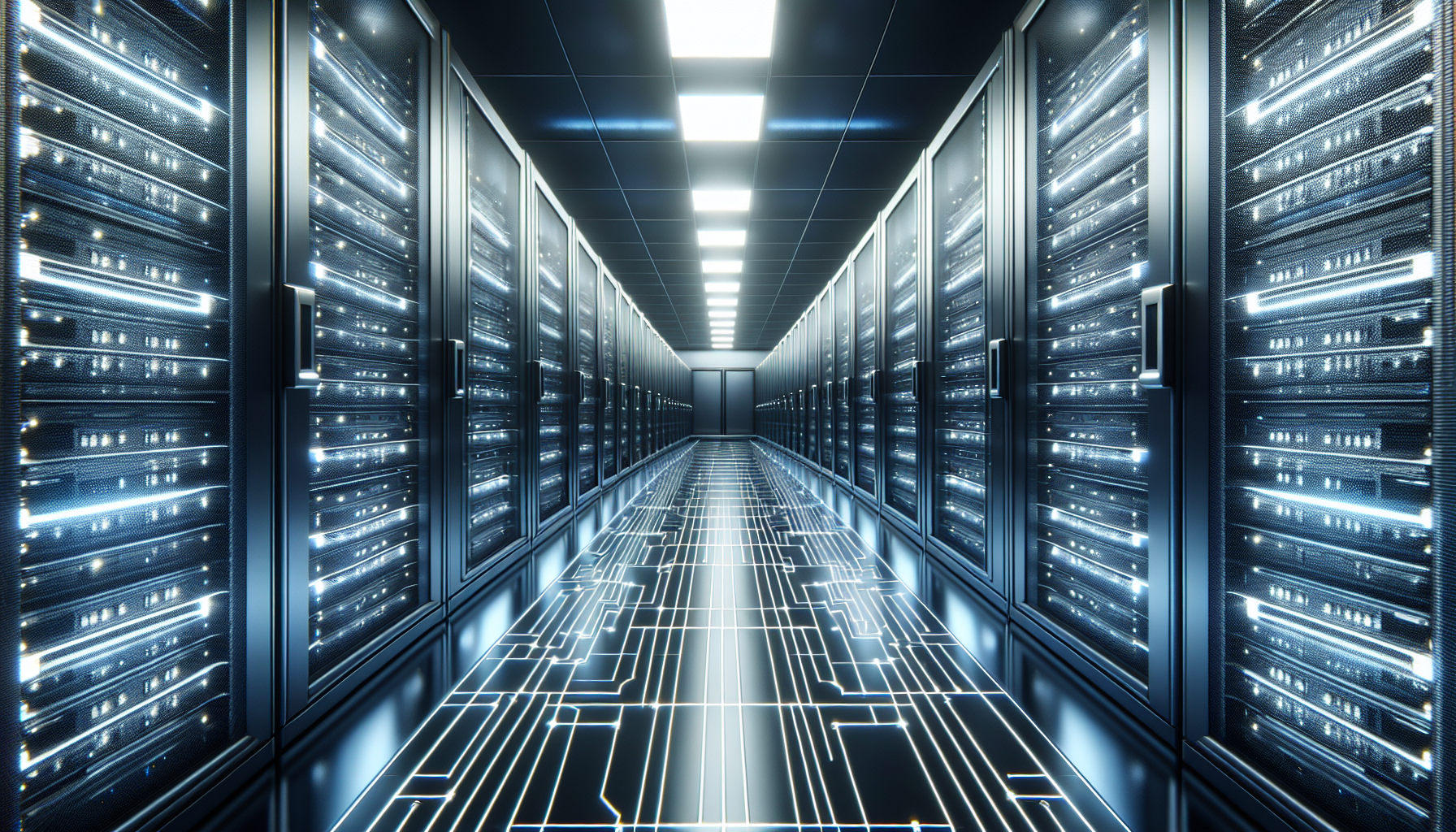In today’s increasingly digital world, the management of physical servers is a crucial aspect that should not be overlooked. It is not just about ensuring the smooth operation of these servers, but also about being mindful of the environmental impact they may have. From energy consumption to proper disposal of electronic waste, there are several important environmental considerations to keep in mind when it comes to physical server management. By understanding and addressing these factors, we can make significant strides towards a more sustainable and responsible approach to technology.
Energy Efficiency
Power Usage Effectiveness (PUE)
Energy efficiency is a crucial aspect of server management that aims to minimize the energy consumption of data centers. One important metric used to measure energy efficiency is Power Usage Effectiveness (PUE). PUE is the ratio between the total energy consumed by a data center and the energy consumed by the IT equipment alone. The lower the PUE, the more efficient the data center is. By optimizing PUE, organizations can reduce their environmental impact and lower their energy costs.
Virtualization
Virtualization is a technology that allows multiple virtual machines to run on a single physical server. By consolidating multiple servers onto a smaller number of physical machines, virtualization helps to reduce energy consumption, cooling requirements, and physical space requirements. This not only improves energy efficiency but also helps to decrease the carbon footprint of a data center. Through virtualization, organizations can achieve higher server utilization rates and more effectively utilize their computing resources.
Server Consolidation
Server consolidation involves the process of merging multiple underutilized physical servers into a smaller number of more powerful servers. This process eliminates the need for excess hardware, reducing power consumption and cooling requirements. By consolidating servers, organizations can optimize their infrastructure, lower their energy consumption, and reduce their environmental impact. It also results in cost savings through better resource utilization and increased efficiency.
Efficient Cooling Systems
Cooling systems play a critical role in maintaining the optimal temperature for the servers and preventing overheating. However, traditional cooling methods can consume a significant amount of energy. Implementing efficient cooling systems, such as hot aisle/cold aisle containment, can improve cooling efficiency and reduce energy consumption. These systems ensure that cold air is directed only to where it is needed, minimizing wasteful cooling and reducing the overall energy usage of the data center.
Power Management Tools
Power management tools offer ways to monitor and control the power consumption of servers and IT equipment. These tools allow organizations to set power policies, schedule server shutdowns during periods of low demand, and automatically manage power usage based on predefined rules. By implementing power management tools, organizations can further optimize their energy consumption, reduce wastage, and contribute to overall energy efficiency efforts.
Renewable Energy Sources
Solar Power
Solar power is a clean and renewable energy source that harnesses the power of the sun to generate electricity. Installing solar panels on the roofs or around the premises of data centers can help to offset the energy consumed by the servers. By utilizing solar power, organizations can significantly reduce their dependence on fossil fuels and decrease their carbon emissions. Solar power is an environmentally friendly solution that can be harnessed to power data centers and contribute to a greener future.
Wind Power
Wind power is another renewable energy source that can be utilized to power data centers. By installing wind turbines in suitable locations, organizations can generate electricity from the wind’s kinetic energy. Wind power is a clean and abundant resource that offers a sustainable alternative to traditional energy sources. Embracing wind power can help data centers reduce their reliance on non-renewable energy sources and minimize their environmental impact.
Hydroelectric Power
Hydroelectric power harnesses the energy of flowing water to generate electricity. By utilizing hydropower, data centers can tap into a clean and renewable energy source. If located near a suitable water source, data centers can connect to a hydropower grid or even install small-scale hydroelectric systems to generate their own electricity. Hydroelectric power is a reliable and sustainable option that data centers can leverage to reduce their carbon footprint.
Geothermal Energy
Geothermal energy utilizes heat from the Earth’s core to generate electricity. Data centers located in regions with geothermal activity can take advantage of this renewable energy source. Geothermal power offers a constant and consistent energy supply, making it an attractive option for sustainable data center operations. By tapping into the Earth’s natural heat, data centers can reduce their reliance on traditional energy sources and contribute to a more sustainable energy future.
Waste Management
E-Waste Recycling
Proper disposal of electronic waste (e-waste), such as old servers and IT equipment, is an essential part of environmentally friendly server management. Recycling e-waste ensures that the valuable materials contained within the equipment are recovered and reused, while hazardous substances are disposed of safely. Organizations can partner with specialized e-waste recycling providers that adhere to strict environmental standards to ensure that e-waste is managed responsibly.
Proper Disposal of Components
In addition to recycling e-waste, it is important to properly dispose of individual components when they reach the end of their useful life. This includes components such as batteries, power supplies, and cooling fans. Many of these components contain hazardous materials that can be harmful to the environment if not disposed of correctly. By following proper disposal procedures, organizations can ensure that these components are handled responsibly and do not contribute to pollution or harm ecosystems.
Reduction of Packaging
Minimizing packaging waste is an effective way to reduce the environmental impact of server management. When new servers or IT equipment are purchased, organizations should encourage suppliers to use minimal packaging materials and to utilize recyclable or biodegradable materials. By reducing packaging waste, organizations can decrease the amount of waste sent to landfills and minimize their overall environmental footprint.
Lifecycle Assessment of Equipment
Performing a comprehensive lifecycle assessment of equipment allows organizations to analyze the resource consumption, environmental impact, and overall sustainability of the servers and IT equipment. This assessment considers factors such as energy consumption, raw material extraction, manufacturing processes, transportation, use, and end-of-life disposal. By understanding the lifecycle impacts of equipment, organizations can make informed decisions about purchasing, disposal, and recycling, thereby reducing their environmental impact.
Water Conservation
Monitoring Water Usage
Monitoring water usage is crucial for data centers to identify areas of water waste or inefficiency. By implementing water metering systems and tracking water consumption, data centers can identify water-intensive processes and develop strategies to minimize usage. Regular monitoring allows for early detection of leaks or abnormal water consumption patterns, preventing excessive water waste and saving valuable resources.
Water-efficient Cooling Systems
Water-efficient cooling systems, such as evaporative cooling or water-free cooling, can significantly reduce water consumption in data centers. These systems use alternative cooling techniques that require minimal or no water usage, thereby reducing the strain on water resources. By adopting water-efficient cooling systems, data centers can mitigate their impact on local water supplies and contribute to water conservation efforts.
Water Recycling and Reuse
Implementing water recycling and reuse systems can further reduce the water demand of data centers. Rainwater harvesting, gray water recycling, and wastewater treatment systems can be employed to collect and treat water for non-potable uses, such as cooling tower makeup, irrigation, or facility cleaning. By recycling and reusing water, data centers can reduce their reliance on freshwater sources and contribute to the conservation of this precious resource.
Carbon Footprint Reduction
Energy-efficient Hardware
Using energy-efficient hardware is a key strategy for reducing the carbon footprint of server management. Energy Star-certified servers and IT equipment are designed to consume less power while maintaining high performance. By investing in energy-efficient hardware, organizations can lower their energy consumption, decrease greenhouse gas emissions, and contribute to a more sustainable IT infrastructure.
Data Center Location
The location of a data center can have a significant impact on its carbon footprint. Choosing to establish data centers in regions with access to renewable energy sources, such as solar or wind power, can minimize reliance on fossil fuels. Additionally, locating data centers near the sources of data demand can reduce the energy required for data transmission, further reducing carbon emissions. Careful consideration of data center location can lead to significant carbon footprint reductions.
Green Building Design
Designing data centers with green building principles in mind can have a profound impact on their environmental performance. Energy-efficient building envelopes, natural lighting, efficient insulation, and smart ventilation systems all contribute to reducing energy consumption and carbon emissions. Additionally, integrating renewable energy generation systems, such as solar panels, can further offset energy use and decrease the data center’s carbon footprint.
Carbon Offsetting
To neutralize unavoidable carbon emissions, organizations can invest in carbon offset programs. These programs support projects that directly reduce or remove greenhouse gas emissions from the atmosphere, such as reforestation initiatives or renewable energy projects. By purchasing carbon offsets, data centers can compensate for their carbon emissions, effectively achieving carbon neutrality and contributing to global climate efforts.
Air Quality
Proper Ventilation Systems
Maintaining proper ventilation systems is crucial for ensuring good air quality in data centers. Adequate air circulation helps remove excess heat generated by the servers and prevent the buildup of harmful airborne contaminants. By implementing efficient ventilation systems, organizations can maintain optimal working conditions for both servers and personnel, ultimately improving air quality and overall performance.
Air Filtering Systems
Installing high-quality air filtering systems is essential for data centers to mitigate the presence of particulate matter and harmful airborne particles. These systems help remove dust, allergens, and other pollutants from the air, creating a cleaner and healthier environment for both the equipment and the personnel. By prioritizing air filtration, data centers can improve air quality, reduce the risk of equipment damage, and promote the well-being of employees.
Reducing Particulate Matter and Emissions
Data centers can reduce particulate matter and emissions by implementing best practices such as regular cleaning, proper maintenance of equipment, and opting for low-emission materials. Clean servers and components have better airflow, reducing the risk of overheating and prolonging their lifespan. Similarly, selecting low-emission adhesives, insulation, and paints can contribute to improving air quality within the facility and minimizing the environmental impact.
Natural Resource Conservation
Reducing Equipment Footprint
Minimizing the physical footprint of data center equipment is crucial for conserving natural resources. Servers and IT equipment are typically housed in racks or cabinets, and utilizing compact and efficient designs maximizes the utilization of space. By reducing the space required for equipment, data centers can minimize the consumption of raw materials, optimize resource usage, and potentially reduce the need for additional construction or expansion.
Reducing Resource Consumption
Efforts to reduce resource consumption should be integrated into all aspects of server management. This includes optimizing server utilization rates, implementing efficient power distribution systems, and employing intelligent power management strategies. By reducing resource consumption, data centers can lower their ecological footprint, promote sustainability, and contribute to the conservation of natural resources.
Equipment Lifespan Extension
Extending the lifespan of servers and IT equipment is an effective way to conserve natural resources. By properly maintaining and upgrading hardware, organizations can prolong its useful life and delay the need for replacements. This includes routine maintenance, equipment refurbishment, and taking advantage of technology advancements without necessarily discarding existing equipment. Equipment lifespan extension reduces waste generation and minimizes the consumption of materials and resources.
Noise Pollution
Soundproofing
Data centers can generate significant noise levels due to the operation of servers, cooling systems, and other equipment. Soundproofing measures, such as acoustic insulation and barriers, can help control and reduce noise pollution, creating a quieter and more comfortable working environment. By implementing soundproofing techniques, data centers can enhance the well-being of personnel and contribute to a more peaceful and sustainable working environment.
Quiet Cooling Solutions
Cooling systems often contribute to the noise levels in data centers. Choosing quiet cooling solutions, such as fans with low noise ratings or water-based cooling systems, can minimize noise pollution without compromising cooling efficiency. By investing in quieter equipment, data centers can create a calmer and more pleasant working space for their employees, improving productivity and reducing noise-related stress.
Server Room Layout
Thoughtful server room layout design can help minimize noise pollution within data centers. Grouping noisy equipment together and isolating them from quieter areas can mitigate the propagation of noise across the facility. Additionally, placing noise-sensitive areas such as office spaces or meeting rooms away from the server room can further improve the working environment. By considering the arrangement of equipment and the layout of the data center, noise pollution can be effectively managed.
Environmental Regulations
Compliance with Legal Requirements
Complying with environmental regulations and laws is essential for data centers to operate responsibly. These regulations may include restrictions on emissions, waste disposal, energy consumption, and water usage. By aligning their operations with relevant laws and regulations, data centers can ensure they meet the required standards and contribute to a sustainable and compliant industry.
Monitoring and Reporting
Monitoring and reporting environmental performance is a crucial aspect of responsible server management. Data centers should establish systems to track and collect data on energy consumption, carbon emissions, water usage, and waste generation. By regularly monitoring and analyzing this data, organizations can identify areas for improvement and make informed decisions to reduce their environmental impact. Additionally, transparent reporting allows stakeholders to assess the data center’s sustainability efforts and hold them accountable for their environmental performance.
Resource Management
Implementing robust resource management practices helps to minimize waste, optimize resource allocation, and reduce environmental impacts. This includes efficiently managing energy usage, water consumption, and waste disposal throughout the data center’s operations. By actively managing resources, data centers can improve their environmental performance, enhance operational efficiency, and contribute to sustainable practices within the industry.
Sustainable Procurement
Environmentally Friendly Suppliers
Choosing environmentally friendly suppliers is an important consideration for sustainable server management. Organizations should prioritize suppliers who demonstrate a commitment to environmental responsibility, such as those who use renewable energy in their operations, employ sustainable manufacturing practices, and offer products with a reduced environmental impact. By partnering with eco-conscious suppliers, data centers can align their procurement practices with their sustainability goals.
Green Certifications
Opting for products and services that hold recognized green certifications or meet specific environmental standards is an effective way to promote sustainable procurement. Certifications such as Energy Star, EPEAT, and LEED indicate that a product or service has been independently verified to meet or exceed specific environmental criteria. By procuring equipment and services with green certifications, data centers can ensure they are making environmentally responsible choices and contributing to a greener industry.
Supply Chain Transparency
Transparency in the supply chain is crucial for sustainable procurement. Data centers should work with suppliers who provide clear and comprehensive information on the environmental impact of their products and services. This information should include details on raw material sourcing, manufacturing processes, waste management practices, and carbon emissions. By prioritizing supply chain transparency, data centers can make informed decisions that support sustainable procurement and reduce their environmental footprint.
In conclusion, environmental considerations for physical server management are crucial for minimizing the ecological impact of data centers. By focusing on energy efficiency, utilizing renewable energy sources, implementing waste management strategies, conserving water, reducing carbon footprints, improving air quality, conserving natural resources, mitigating noise pollution, adhering to environmental regulations, and embracing sustainable procurement practices, data centers can contribute to a more sustainable and environmentally friendly industry. Through these initiatives, organizations can lower their ecological footprint, increase efficiency, achieve cost savings, and positively impact the planet for future generations.












